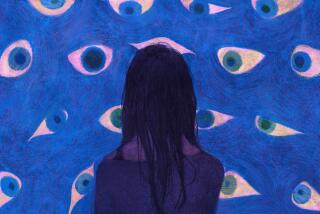A Vision of Loveliness to Frame the Face : Fashion: Eyeglasses once projected a nerdish image. Today, thanks to designers and high-tech plastic, they are a clear statement of style.
- Share via
Once upon a time, corrective lenses made their own kind of peculiar fashion statement: nerd, owl, egghead, four-eyes.
“Now we’re in a time where two forces come together: fashion and function,” says Carl Zyskowski of Civic Center Opticians in Connecticut.
Corrective was the operative word before high-style designers lent their names to frame shapes and technology married old-style etched metal with lightweight tortoise-pattern plastic in almost any shade imaginable. In the bleak old days, you had a choice of black, tortoise shell, smoke and taupe in rather severe shapes. If they were flattering, it was merely coincidental.
But today, some people consider frames so stylish that they wear them with clear lenses to look older or wiser. Or even younger.
One-time presidential candidate Paul Tsongas was seen trying on different frames before a debate.
“I don’t need them,” he told a reporter later, “but my advisers think I look better because they hide the bags under my eyes.”
“I have one client who’s a 25-year-old newscaster in Washington, D.C., who wants to look more serious, so we fitted him with frames, even though he has perfect vision,” Zyskowski says.
But for those who see life as a fuzzy Monet watercolor instead of a sharp Norman Rockwell illustration, there’s no need to surrender style for sight.
“We’re showing advances in both frames and lenses,” says Henry Sand, senior vice president of sales and marketing for Luxottica, an Italian-based company that is the largest frame maker in the world.
Five years ago, Luxottica paired with Milan designer Giorgio Armani.
“It was at that point we became a high-fashion producer and eyewear became a true fashion item,” Sand says.
Zyskowski credits Los Angeles-based frame designer Oliver Peoples for setting a style “that everybody imitated.”
No matter what the source of fashion influence, here is what is hot: smaller, rounder frames in shades of tortoise shell blended with metal. Lenses are plastic and thinner.
The industry is calling them vintage.
“Think of Harold Lloyd with his round tortoise-shell glasses and you have a starting point,” Sand says, proving the fashion adage that “everything old is new again.” (Lloyd, a contemporary of Charlie Chaplin and Buster Keaton, was a physical comedian in silent screen movies who invented a character named “Glasses,” an upwardly mobile young college man with spectacles who first appeared in “Over the Fence” in 1917.)
Smaller frames are more vintage than the huge plastic frames so popular in the late 1970s.
The large frame boom occurred “when technology drove fashion, and not the other way ‘round,” Zyskowski says.
But in a sense technology always drives what the fashion designer can do. When glass was the only option for the lens, frames were smaller because glass is heavier. Technology is giving wearers previously stuck with Coke-bottle lenses new, thinner options. A material called high-index plastic allows for great refraction in widths up to 60% thinner.
Frame makers now worry about cycles of acceptance in frame styles. The most successful frames are in the market for about 10 years, Sand says.
Marketers look for ways to sell glasses by figuring what motivates people to buy.
“Half the world wants to be different, and half the world wants to be the same, so you have to start there,” Sand says. What actually happens, he says, is that “about five years ago, the hippest started to wear the smaller, round frames.”
Sand calls them the “innovators,” about 5% to 10% of the buyers. They are followed by the “early adapters,” another 10% who like to try new style trends but don’t want to be the first. Then comes the “early majority,” another 30% of the market, who want to be sure something is in before adopting it. Sand says this is where the round lenses are now.
Next comes the “late majority,” another 30%, then the “laggards,” 10%, and last the “standards,” those who pick up the trend and stick with it forever. (See newscaster John Chancellor, who is actually back in style with his tortoise-shell glasses, which he’s been wearing for decades.)
So what are the innovators wearing that will run through the stages to become standards?
“That would still be small frames, but more oval shaped,” Sand says.
Running its way through the chain are the plastic Carbolyt frames, slightly larger and more squarish.
“That was a frame that began to sell in 1983 and is still a very strong seller,” Zyskowski says.
This year about 35 million people have the potential to find that their arms are too short to read the paper.
Presbyopia, eye doctor lingo for farsightedness in aging eyes, eventually hits everyone, but it is most prevalent in baby boomers between 40 and 50.
“That’s when we start seeing them, if we haven’t seen them before,” says Howard Gottlieb, president of New England Eyecare in West Hartford, Conn.
Almost 150 million adult Americans--six in 10--wear prescriptive eyewear. Eighty-one percent have glasses, according to the Vision Council of America; 3% have only contact lenses, and 16% have eyeglasses and contact lenses. Total sales of prescription-related optical products was $11.5 billion in 1991, slightly up from the year before.
More to Read
The biggest entertainment stories
Get our big stories about Hollywood, film, television, music, arts, culture and more right in your inbox as soon as they publish.
You may occasionally receive promotional content from the Los Angeles Times.










